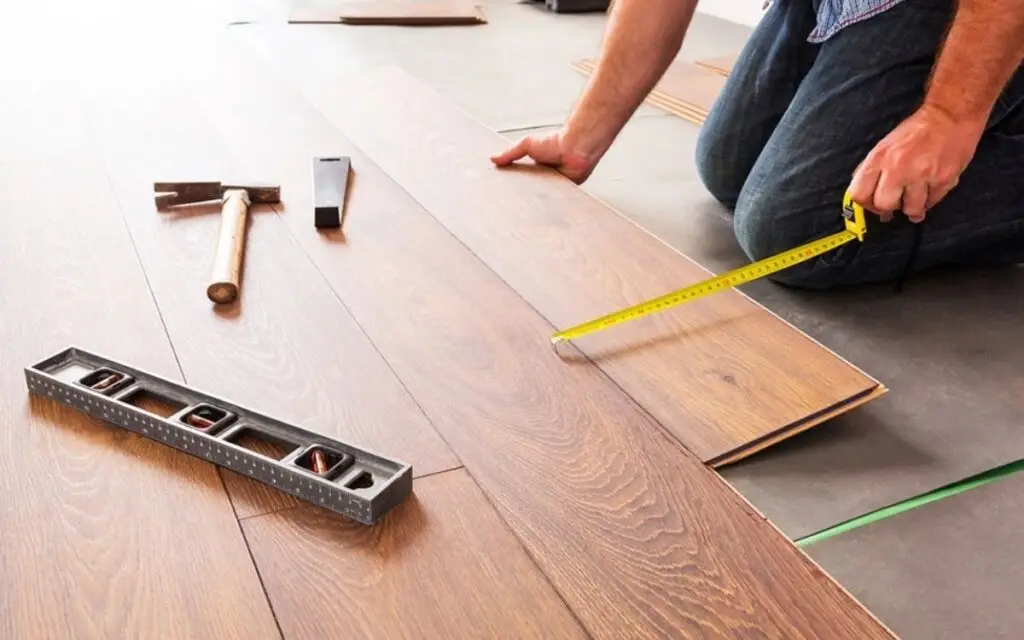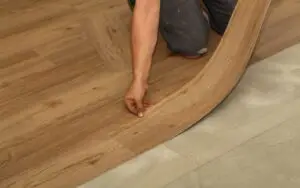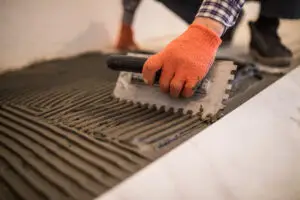The Allure of Laminate Flooring: A Closer Look
What Makes Laminate So Popular?
Laminate flooring has risen in popularity due to its affordability, versatility, and ease of installation, offering homeowners an alternative to hardwood, tile, and other more expensive flooring options. The advancements in laminate technology have made it a more attractive option with better graphics and textures that more closely mimic real wood or stone, and improved durability to withstand daily wear and tear.
The Initial Appeal: Cost and Aesthetics
One of the primary draws of laminate flooring is its budget-friendliness, making it a popular choice for homeowners looking for a stylish floor without breaking the bank. The wide variety of designs, from classic oak to contemporary gray tones, and its ease of install make it ideal for many homeowners. However, despite the initial appeal, laminate flooring has several drawbacks that homeowners should consider before committing to it as their primary flooring material.
Hidden Downsides of Laminate Flooring
Susceptibility to Water Damage
Issues with Spills and Moisture
While laminate is water-resistant, it is not waterproof. Spills that are not cleaned up quickly can seep into the seams and cause the underlying core to swell, leading to buckling, warping, and eventual damage. This is especially problematic in areas prone to moisture, such as bathrooms, kitchens, and entryways.
How Water Damage Affects Laminate
Once water damage has occurred to laminate flooring, it’s often irreversible. The swelling can lead to uneven surfaces and visible damage to the planks. This not only compromises the aesthetic appeal of the floor but also reduces its structural integrity, requiring potentially costly replacements. This damage highlights the importance of not only purchasing a quality flooring, but also making sure that it is professionally installed to prevent future damage.
Prone to Scratches and Dents
Everyday Wear and Tear
Laminate flooring, despite its durability, is susceptible to scratches and dents from everyday wear and tear. High heels, furniture movement, and even pet claws can easily mar the surface of laminate flooring over time. These scratches can accumulate and make the flooring appear worn and unattractive much more quickly than other flooring options.
Impact from Furniture and Pets
Dragging furniture across a laminate floor can cause deep scratches, while dropped objects can leave dents. Pet claws can also do significant damage if not properly managed, as pets tend to run and play indoors, especially on hard surfaces such as laminate. These damages are difficult to repair and often require replacing the damaged planks or, sometimes, the entire floor.
Can Be Noisy
Hollow Sound and Echo
Unlike solid wood floors which have a more substantial feel and sound, laminate floors often produce a hollow and echoey sound when walked upon. This is because the planks are not directly attached to the subfloor, creating a space that amplifies noise. This can be particularly irritating in multi-story homes or rooms with high ceilings.
How to Reduce Noise Issues
While adding underlayment can help slightly reduce the noise, it doesn’t always eliminate the problem completely. The best solution is often to choose a higher-quality laminate flooring, but that adds to the costs. A professional installer can also help by ensuring the subfloor is properly prepared before installation, but the core of the issue is in the product’s design.
Lower Lifespan Compared to Other Options
Durability Limitations
Laminate flooring typically has a shorter lifespan compared to hardwood or tile. While quality laminate can last 10-20 years with proper care, it is not as resistant to heavy wear and tear as other materials, which can last for decades or even a lifetime. When compared to other flooring options, laminate requires more maintenance and will need to be replaced sooner, costing more money and time in the long run.
Replacement and Maintenance
The need for more frequent replacements and maintenance not only adds to the cost but can also be disruptive. Hiring professionals to install flooring not only increases the lifetime of your floor, but also the long term value of your home, protecting your investment.
Can Fade Over Time
Exposure to Sunlight
Prolonged exposure to sunlight can cause laminate flooring to fade over time. This is more apparent in rooms with large windows where direct sunlight is common, changing the color and affecting the overall appearance of the flooring. This uneven fading can become quite noticeable over time and may require full replacement.
Color Changes
The fading is typically not uniform, leading to variations in color, which makes the flooring look old and poorly maintained. This can be frustrating to homeowners who want a consistent and attractive look. A professional can discuss the best option for preventing this before the flooring is even installed, based on your specific property.
Not as Authentic as Real Wood
Aesthetic Limitations
Despite advancements in technology, laminate flooring does not quite replicate the authentic look and feel of real wood. The repeating patterns can make it look artificial, especially in large areas, diminishing the luxurious look one might be trying to achieve. The texture is also not as natural as real wood, which can be felt when walking on the floor.
Lack of Unique Grain Patterns
Each piece of real wood flooring is unique, with its own grain and color variations. Laminate floors have repeating patterns, making them less visually appealing to those looking for an authentic look. This repetition can be a significant drawback for those seeking the warmth and natural feel of real wood.
Installation Challenges
Importance of Proper Subfloor
The success of laminate flooring installation largely depends on the condition of the subfloor. If the subfloor is uneven, it can lead to gaps, squeaking, or buckling in the laminate floor. Proper preparation of the subfloor, which is often overlooked by DIYers, is crucial for a long-lasting and flawless installation.
Issues with DIY Installation
DIY installations often run into problems that could have been easily avoided by a professional. Common issues include improper measurements, incorrect placement of the underlayment, or not aligning the planks correctly. These small errors can have a significant impact on the look and lifespan of the floor. By hiring a professional, you’re investing not just in the installation, but in the longevity of the flooring itself.
DIY vs Professional Installation
Risks of DIY Installation
Common Mistakes and How to Avoid Them
DIY installations can lead to many errors, such as improper subfloor preparation, uneven plank alignment, or gaps that leave the floor vulnerable to moisture. These errors can lead to the floor failing prematurely, or to costly repairs to fix. By hiring a professional, you avoid these errors and also avoid time-consuming and costly mistakes.
Benefits of Professional Flooring Installation
Expertise and Precision
Professional flooring installers have the experience and knowledge to install laminate flooring correctly the first time. They know the nuances of flooring installation that can make a huge difference in the appearance and longevity of the floor. This is not something a homeowner would know, and is one of the major benefits of hiring a professional.
Long-Term Cost Savings
While it may seem expensive to hire a professional initially, the long-term savings in avoiding costly repairs, replacement, and the peace of mind in knowing it was done right is something a homeowner cannot put a price on. Professionals also often have better access to quality materials and can provide advice on maintaining your flooring, helping it last as long as possible.
Case Study: DIY Horror Story
Common Damage
A homeowner, attempting to save money on labor costs, opted to install laminate flooring themselves. They didn’t properly level the subfloor and didn’t use the correct underlayment, leading to uneven flooring, squeaking, and gaps. Within a few months, some of the planks buckled, and the edges lifted from high-traffic areas.
What a Professional Would Have Done Differently
A professional installer would have assessed the subfloor condition first, ensuring it was level and dry. They would have chosen the appropriate underlayment for the specific type of laminate and would have installed it with precision, leaving no gaps or uneven areas. This would not only have extended the life of the flooring but would also have saved the homeowner from the expensive and frustrating experience.
Case Study: Professional Installation Success
Flawless Installation
A homeowner decided to hire a professional installer for their laminate flooring. The installer ensured a level subfloor, used high-quality underlayment, and installed the planks with precision. The result was a smooth, even, and durable floor that looks stunning.
Long-Term Benefits
Years later, the floor still looks great, with no signs of damage or wear and tear. The homeowner was happy with their decision, and thankful that they did not try to take on the process themselves. This shows that hiring a professional offers peace of mind that the job was done right.
FAQs & Answers
While it's tempting to install laminate flooring yourself to save money, the precision required for a long-lasting result often necessitates professional help. Improper installation can lead to issues like uneven floors, gaps, or susceptibility to moisture damage, which can be costly to repair later. Professionals have the tools, knowledge, and experience to ensure a flawless and durable installation, avoiding many common pitfalls that DIYers face. Hiring a professional not only guarantees a quality result but also protects your investment by minimizing potential problems down the line.
Laminate flooring is generally water-resistant, not waterproof. While it can handle small spills if wiped up quickly, prolonged exposure to water can cause the core of the plank to swell and warp, leading to irreversible damage. This is especially true at the seams and in areas with consistent moisture. Unlike professional installations which often include proper sealing and attention to areas prone to moisture, DIY efforts may not adequately address these vulnerabilities, leading to expensive repairs or complete replacement. Professional installers are trained to address these problems and provide the best outcome possible to prevent water damage.
While minor scratches on laminate flooring can sometimes be addressed with touch-up pens or repair kits, they can often be difficult to fully conceal. Deeper scratches and dents are typically impossible to fix without replacing the affected planks. This is a common issue that can greatly detract from the appearance of your floor over time, especially in high-traffic areas or homes with pets. Professional installers understand how to choose the best products and methods to minimize this type of wear and tear from the beginning.
Laminate flooring generally has a shorter lifespan compared to hardwood or tile flooring options, typically lasting around 10 to 20 years if well-maintained. Its composite construction makes it less resilient to wear and tear over the long term compared to solid wood or stone, both of which have longer lifespans with proper care. While a professional installation can maximize the lifespan of laminate flooring by ensuring correct subfloor preparation and installation, the material itself is not designed for long-term durability compared to these other options.
The hollow sound you often hear when walking on laminate flooring is due to its construction and how it is installed. Laminate planks are not solid material and are installed as a floating floor, meaning they are not directly adhered to the subfloor. This can create an air gap beneath that can amplify noise, particularly in areas without proper padding or underlayment. While some DIYers try to correct this issue, it's challenging to do so without the experience of a professional, who can not only install a quality underlayment from the start, but ensure the flooring is installed to reduce this hollow sound.





